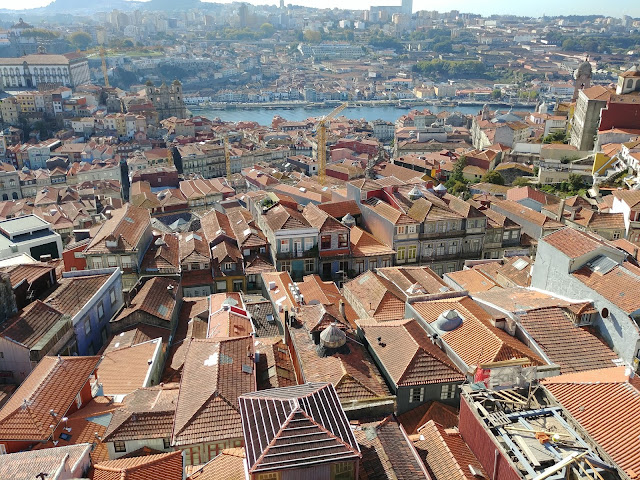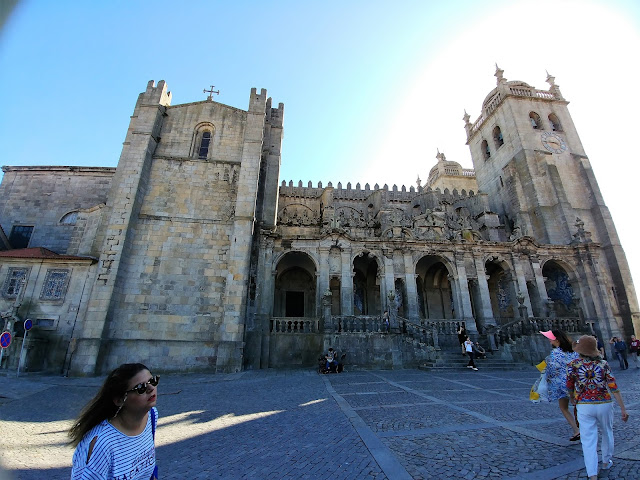Porto. Portugal
Sometimes shit happens. So I guess it should be no surprise
that eventually it would.
We arrived in Porto, Portugal on our Iberian flight from
Granada and hailed a cab to the apartment we rented on the Ribiera. We arrived
to find that they did not have our reservation. Several frantic calls later we
discovered that our confirmed Expedia reservation had somehow been cancelled and
Expedia had failed to notify us. With the help of Bruno, the young man working
at the apartments, we were able to secure a place downtown for the first night
then he could get us into another of their apartments the second night and into
the apartment we had originally rented on the Ribiera for the last two. Not
ideal, but at least we had a place to stay and we would see several areas of
the city as well.
Porto dates back to 300 BC. It was at times under Roman rule,
and for a short time Moorish. In 1387 the marriage of John I of Portugal and
Phillipa of Lancaster formed the longest standing alliance between Portugal and
England.
In the 14th and 15ht century Porto’s shipyards
played a big part in the development of Portugese ship building. The evidence
is still there, on Villa de Gaia side of the river.
Henry the Navigator, son of John and Isabel, embarked on the
conquest of Africa and Morrocco and began the Portuguese Age of Discovery,
ultimately building a strong and wide spread Portuguese empire. Portuguese remained a monarchy until 1910 when it won its independence and became a republic.
The Douro Valley was already producing wine in the 13th
century and continues to be a significant export
today, with port wine being
their flagship.
We spent four days in Porto and were able to cover a lot of
ground despite our daily moves.
1.
Ribiera promenade with restaurants, shops
Wander down the steep and winding alleyways
and stairs from upper Porto down to the Ribiera. Here a wide promenade follows
alongside the River Douro, dotted with restaurants, cafes, shops and boutique
hotels.


Six bridges span the river between Porto and Villa Nova de Gaia on the
other side. Long boats traverse the river packed with tourists or port wine
barrels.
2.
Six bridges and boat tour.
Six bridges span the river as it curves
through Porto and Villa Nova de Gaia. The most notable is the Ponte Luis I
bridge, designed by Gustave Eiffel (builder of the Eiffel Tower). It has a
double deck, the upper being for buses and the lower for cars. Pedestrians can
walk across either one with magnificent panoramic views of both sides of the
river.
To cross the upper deck of the bridge,
first you have to get up to that level. You can access it from central Porto,
or take the funicular up from the lower level and then walk across.
Down by the river`s edge on the Gaia side
of the river you will see a host of long boats lined up along the shore. Most
offer tours that cruise up and down the river passing under the six brides and
providing history of each. A great way to spend a sunny afternoon.
Porto, or more accurately, Villa Nova de
Gaia is where Port Wine is cellared and aged and shipped all over the world. There
are over 50 port wine lodges and most offer tasting and cellar tours where you
can learn about pot and how it is produced. Some of the best are Calem which is
very near the bridge and produced excellent ports. You might also want to try
Sandeman, Taylor, or Offley.
4.
Hop-on Bus to the Atlantic ocean and beaches
Every city you travel to has hop-on hop-off
bus tours and Porto is no exception. You can take the red line, the blue line,
the blue bus, the yellow bus; it really doesn`t matter. It can be a great way
to get around the city and see a lot of the key attractions at your own pace.
We decided to take the bus to visit the
Atlantic shore. Here the rugged Atlantic crashes against a rocky shore. The
sand is the color of golden brown sugar but quite course and grainy, not ideal
for walking barefoot on the beach. The strength of the waves grinds any beach
glass to tiny green shards in the sand and polishes beautiful marble-like
pebbles to a shine.
The bus continues on its loop down to the
Riberia and across the bridge to Villa Nova de Gaia. A great way to see the city.
5.
No. 1 Tram historic route and Lighthouses where
River meets Ocean
 Another way to sight see around Porto is the
historic No. 1 tram that rumbles along an aged track through old downtown and
along the riverside. The tram has been running since 1895 and retains its
vintage look and feel, ending at the point where the Douro River meets the
Atlantic. Here long sturdy breakwaters break the powerful and dangerous
currents where the two meet, a dangerous spot where many seamen have lost their
lives.
Another way to sight see around Porto is the
historic No. 1 tram that rumbles along an aged track through old downtown and
along the riverside. The tram has been running since 1895 and retains its
vintage look and feel, ending at the point where the Douro River meets the
Atlantic. Here long sturdy breakwaters break the powerful and dangerous
currents where the two meet, a dangerous spot where many seamen have lost their
lives.
We decided to take this little trek on
Tuesday, which happened to be a very foggy morning. The fog hung low over the
water creating a misty blanket. Each breakwater was marked with a lighthouse, barely
discernible in the fog. Thundering waves crashed against the massive concrete
walls, swelling and occasionally breaking over the walls and spilling onto the
walls where people walked.
Across the street sits a beautiful old
fort, one of the best preserved we saw in Portugal. It is owned by the
Department of Defense and still used by them but visitors are allowed to wander
through much of it.
The sun finally burned of the fog and the
afternoon was hot and sunny, good for a long walk back along the river, with
the golden autumn leaves framing the graceful bridges and the brilliant blue
water.
6.
Clerigos Church – climb the tower- 360 view
Clerigos Church, or Church of the
Clergymen, is a Baroque style church with a tall bell tower, built in the
1700`s. The tower is 75 metres high with 240 steps to the top of its 6 floors.
It is the jewel in the crown of Porto. Visitors can climb to the top and take
in spectacular views across the city, the river and to the ocean.
Everywhere in Porto, and in Portugal, you
will see beautiful blue- patterned tiles adorning churches, homes, storefronts.
Most depict designs and drawings or scenes.
Probably the most impressive are inside
Porto`s Sao Bento train station downtown. Here the beautiful mosaic tiles
depict the history of transportation from ox carts to the first train.
8.
Cathedral Se, Cathedral of the Assumption of Our
Lady.
This Cathedral was built between the 11th
and 13th centuries with additional alterations in the 1700’s. It is
one of the oldest and most important monuments in Porto.
As is the norm here, the blue tiled panels are evident, depicting important events or honoring patron saints.
As is the norm here, the blue tiled panels are evident, depicting important events or honoring patron saints.

9.
Food and Wine- port, sangria, vino verdhe,
pastries, francesinha sandwich, seafood
  |
| The francesinha sandwich, a Portuguese traditional food., and seafood - another favorite. |
You can get sangria, much like Spain, but
you can also get Sangria made with port wine.
Of course port wine is popular for after
dinner, especially with chocolate and in the summer Vino Verdhe, a young crisp
white wine that is not fully fermented.
Whether you are in the Centro area or down
along the Ribiera, there are plenty of restaurants to try out.
10.
Sunset over River Dourro, bridges and the Ribierra
As the sun begins to set the bridges are
lit with golden colors and the sky begins to glow with shades of pink and
purple, People gather on the higher spots overlooking Porto and Gaia. It is the
perfect time to have a glass of wine on an outdoor patio or stroll across the
Ponte de Luis I bridge as the setting sun lights up the colored houses along
the river.
11.
City Hall Square and Imperial McDonalds
In the downtown area of Porto you can find
a long, narrow square. At one end is a statue of King Pedro IV, hero of the
1832 Civil War. At the other end is the magnificent City Hall or Camara
Municipal.
It also is the site of the Imperial McDonalds,
the fanciest in Europe. Formerly the Imperial Café, it has frescoed panels on
the walls and glistening chandeliers throughout. And, it still provides am Egg
McMuffin for a quick and inexpensive breakfast.
12. Bruno!!!!
Even though the sites may be unforgettable
and awe-inspiring, there is nothing that parallels exceptional service and a
genuine helping hand when someone, especially a young person, puts themselves out
of their way to help out when there is no real benefit to them to do so. And
that`s what Bruno did… Obrigada Bruno.
Four days in Porto flew by. I wish we had had a little more time to really enjoy it, but we are on to Lisbon now for our last stop. Come With Me...
More Porto favorites..
Four days in Porto flew by. I wish we had had a little more time to really enjoy it, but we are on to Lisbon now for our last stop. Come With Me...
More Porto favorites..



















































No comments:
Post a Comment